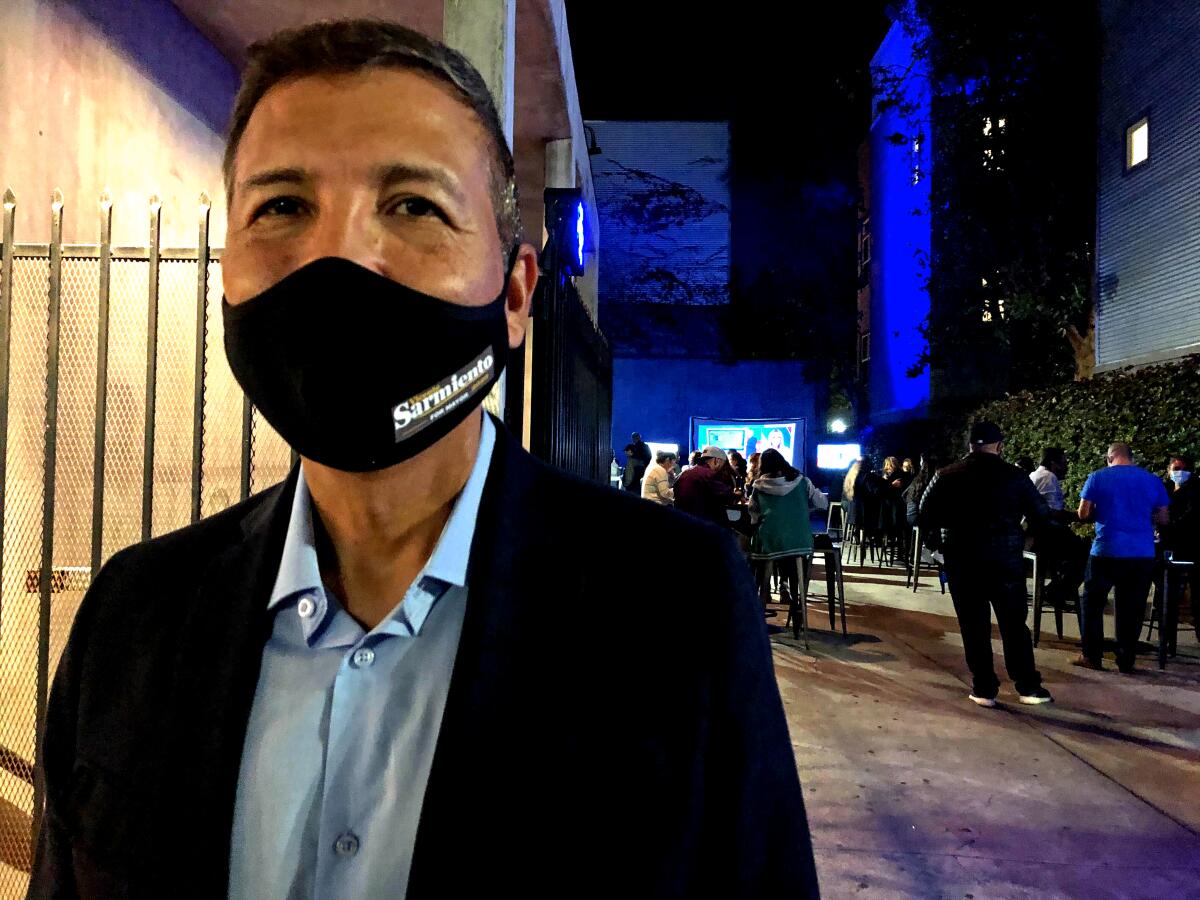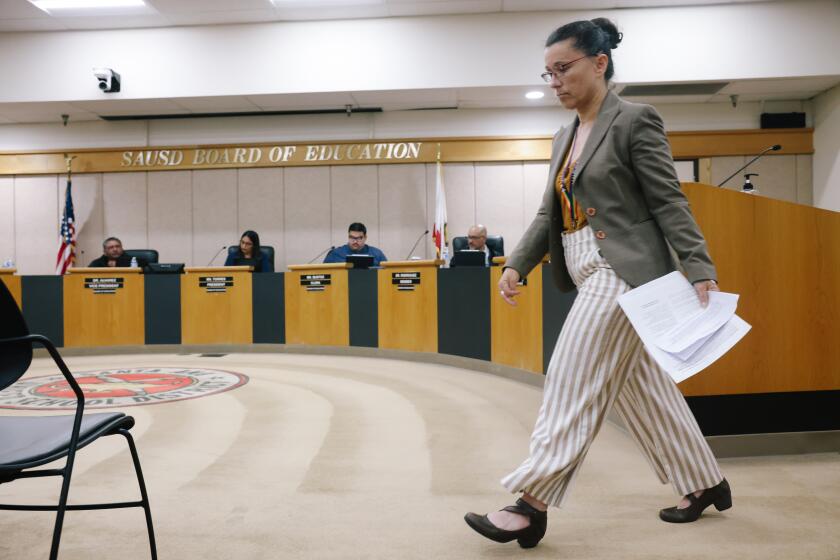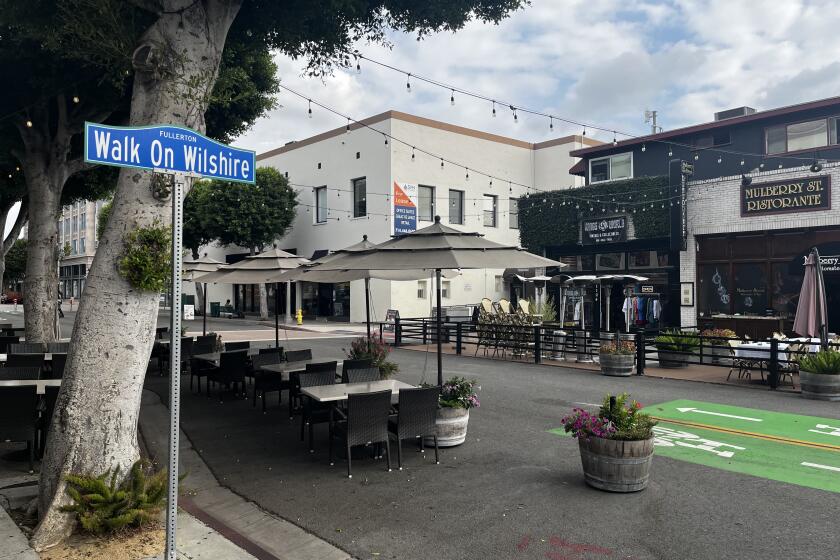Q&A: New Santa Ana mayor aims to improve pandemic response, housing affordability and police oversight

- Share via
This year’s election was historic for Santa Ana as Vicente Sarmiento replaced outgoing Mayor Miguel Pulido, who termed out after 26 years.
Sarmiento ran as possibly the first Bolivian American mayoral candidate, and earned the trust of voters with a platform that put Santa Ana’s most vulnerable residents front and center.
Sarmiento, who served three terms on the City Council, is taking the reins amid skyrocketing COVID-19 numbers and the economic crisis it caused.
TimesOC spoke with Sarmiento about his plans and goals.
Q: What are some of the main issues you are looking to take on during your term?
A.) The first issue is probably going to be the one that’s going to consume most of our attention and time — at least in the first weeks and months of my tenure — is the COVID crisis in Santa Ana.
The city has a disproportionately high number of positive cases relative to the rest of the county … Santa Ana has some ZIP codes ranging above 20% positivity rate. Our initial efforts will be to provide resources, support and testing to make sure our community gets help. That is probably going to be Priority One.
On the tail end we are going to have to be tackling the economic crisis. We see a lot of businesses struggling, and in some cases failing, during these past nine months. That will be my concurrent effort, to get people healthy and deal with the public health crisis, but also try to provide relief and support for our small businesses to make sure they survive this very difficult economic crisis as well.
Do you have some specific ideas or programs planned to tackle these things?
For the public health crisis, I think we have been very successful in providing the testing and ancillary resources and bringing those to neighborhoods that have been impacted. We embed ourselves through our CARES Act team in the ZIP codes with the highest positivity rate … We have taken the services and support directly to the neighborhoods.
It’s maybe a bit more cumbersome and challenging but we have seen people have responded well and trust when you are actually knocking at their door and saying you want to help them with rental assistance and protective gear.
All those things are a different way of providing services to people. We have found it to be very successful in Santa Ana because we have an issue with residents trusting and being able to access support and resources.
Are there any programs you’d want to expand?
What we would like to do is use funding a little bit more intelligently for small businesses, be a little bit more surgical with the monies we have as opposed to just putting it out there and using a blunt instrument and making it available to folks on a first-come, first-served basis.
I think we really need to identify those businesses that may not have been able to open since March 15 or those that have had limited openings and try to find them and provide those grants and monies to them so they can sustain themselves.
In the past I think the way it’s been done is to just make the grants available, but sometimes it doesn’t reach those who are most vulnerable and most impacted. What I’d like to do is identify those businesses that are really really struggling.
Are there some shortcomings from the past mayor in dealing with the pandemic that you think you can improve on?
I think there are, just because the community needed to be reassured that their local government is present and able and willing to help. I think the outgoing mayor, my predecessor, was probably not as visible as maybe he could have been.
Simply by being at food distribution efforts and resource fairs gives a lot of comfort to residents knowing that their elected officials, and especially their mayor, [are] sympathetic and compassionate and concerned about what is going on with their lives.
The second part of that is really trying to do as much as you can to bring resources to the city because we are so different from the other [33] cities ... We have a high population of Latino essential workers that have underlying health conditions. That is a formula for some real serious consequences.
Advocating for more-focused efforts for here in these communities would have been more helpful, and trying to accelerate the funding to get to us. We went months without getting anything and it was really troubling.
So you will plan to be more present in the community?
Yeah, and I have been throughout his pandemic. Since it started, we realized that the food insecurity and the need is so high that people do feel reassured that they have not only these food distribution efforts but also local government that is supporting that.
So when it comes to offering rental assistance, help with utility bills, testing and all these other things, they are all based upon trust. If the residents don’t trust the source, then they won’t access them. I think they have to see that you are present and you are there supporting these efforts thereby making them credible and accessible.
What do you think needs to be done to get those COVID numbers down?
I think it’s a combination of two things that need to be done. One of them is just really instilling this sense of urgency in the community that they need to for the next few months understand that these are going to probably be the darkest months of the pandemic… It is instilling not a sense of fear but a sense of urgency that they need to do everything they can.
We are going to be kicking off a campaign in partnership with Santa Ana Unified, the county and Latino Health Access on Thursday to push that out to the entire city, especially those communities where we have seen those numbers spiral up.
The second thing is compliance. Some businesses are good actors and have been complying to their detriment. Then there’s some others businesses — because there is mixed messages from folks like the sheriff in Orange County — saying they are not going to enforce the state orders.
I think that is very challenging for those of us in cities like Santa Ana that are impacted so heavily. We are trying to tell folks, ‘stay home, don’t open up.’
Are there one or two major issues you’d like to focus on aside from the pandemic?
There’s three or four big issues that I ran really strongly on.
One of them is to address the affordability question when it comes to housing. How do we address the problem of people living sometimes two or three families to a unit? That tells us these overcrowded conditions aren’t voluntary; they are a consequence of rents increasing and outpacing salaries and earnings people have in the city.
The other one is over the summer we dealt with a lot of social justice questions and concerns about accountability from our police officers and our public safety staff. We are going to be looking at the question and a civilian oversight board and what that looks like for a city like Santa Ana.
The other one is we have one of the youngest cities in the country. I heard over and over while campaigning and on the council that our youth really feel ignored for a couple of reasons. They feel that they are not heard and listened to when it comes to what sort of programming and resources they need. Secondly, they don’t feel there’s a proportionate amount of funding that goes to investing in youth. That will be something I will be very interested in pursuing.
Finally, we have a large immigrant population, many undocumented, and I plan to do what I can to make sure there is good public policy coming out of our community. That will hopefully be an expansion of what we started a few years ago and that’s the deportation defense fund that provides legal counsel to people and families who are in the process of being deported or separated. Those are the four big issues. There are plenty of others.
What are the biggest challenges that stand in the way of you solving those issues?
I think any time you talk about housing policy it’s always resistance from the apartment owners, and the California Apartment Assn. is a big lobby for the apartment owners. I understand we certainly don’t believe policy should be overtly harsh on landlords or property owners but it’s a matter of having balance and making sure we also provide some level of affordability for our families that have lived in our community for years. I think there will be resistance there.
I think a public safety oversight commission or board, I think it polls really high … If you think about it we spend close to 60% of our general fund on public safety and we don’t have any civilian or resident commission or body that monitors those departments.
We have commissions for arts and culture and historic resources and parks and rec, and so it begs the question as to why the community wouldn’t be involved in at least opining and having a voice in how their dollars are spent on policing policy.
Do you have ideas on how to tackle the housing affordability crisis in the city?
We had a pretty effective affordable housing policy but it was watered down in the last four months of the outgoing council’s term. We had a 15% requirement that any market rate development had to have a 15% in-lieu fee paid or 15% of their unit mix had to be made available for residents that qualify for affordable housing. I am hoping we can get back to that.
Do you think your election signals a change in Santa Ana residents’ thoughts or goals?
I think there was obviously a clear and decisive margin that we saw in the election not only in the mayoral but the other three council members that were elected. One council member unseated an incumbent and that doesn’t happen often in Santa Ana. You have the three council members and myself talking about the very issues I just mentioned, which is affordable housing, immigrants rights, having accountability with our police officers and all our employees and investment in youth. Those were some prevailing themes through all four campaigns.
All the latest on Orange County from Orange County.
Get our free TimesOC newsletter.
You may occasionally receive promotional content from the Daily Pilot.




